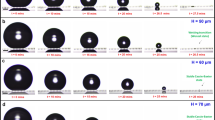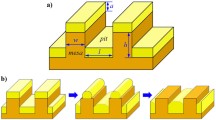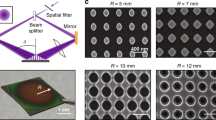Abstract
Nanostructured surfaces with dimensions on a scale of a few millimeters exhibit remarkable hydrophobicity. The geometry of these nanostructures considerably affects their wettability. However, determining the optimal geometry is challenging due to the abundance of geometry parameters and the difficulty in numerically describing their effects on wettability at the mesoscopic scale. In addition, the fabrication of nanostructured surfaces with precise geometries is challenging. We establish a lattice Boltzmann method (LBM) model to address these challenges. We use the model to gain mesoscopic insights into the interaction between droplets and nanostructures. Our model can accurately reproduce contact angles (CAs) on various nanostructured surfaces and enables investigation of the effects of nanostructure geometry on wettability. We optimize the geometry of the nanostructures using the insights provided by the LBM model on the wettability mechanisms. Our analysis indicates that cones with dimensions of 40 µm in width and 33 µm in height exhibit the highest hydrophobicity. We successfully fabricate a superhydrophobic surface with the desired geometry via laser scanning, achieving a CA of 163°. We believe that this approach, which combines the LBM model and laser manufacturing, will enable a better understanding of the wettability mechanism and provide a high-performance approach for fabricating superhydrophobic surfaces.
Similar content being viewed by others
References
Jing X, Zhai Q, Zhang D, et al. Wettability and frictional properties on zirconia surfaces irradiated by femtosecond laser. Colloids Surfs A-Physicochem Eng Aspects, 2022, 654: 130198
Li L, Jin X, Chen J, et al. Anionic surfactant with enhanced interfacial wettability control capability for residual oil development. Colloids Surfs A-Physicochem Eng Aspects, 2022, 655: 130073
Zhang Z, Zhang Y, Liu D, et al. Bubble behavior and its effect on surface integrity in laser-induced plasma micro-machining silicon wafer. J Manufacturing Sci Eng, 2022, 144: 091008
Zhang Z, Liu D, Zhang Y, et al. Fabrication and droplet impact performance of superhydrophobic Ti6Al4V surface by laser induced plasma micro-machining. Appl Surf Sci, 2022, 605: 154661
Zhang Z, Qiu W, Zhang G, et al. Progress in applications of shock-wave induced by short pulsed laser on surface processing. Optics Laser Tech, 2023, 157: 108760
Lai Y, Huang J, Cui Z, et al. Recent advances in TiO2-based nanostructured surfaces with controllable wettability and adhesion. Small, 2016, 12: 2203–2224
Zhang Y, Chen Y, Shi L, et al. Recent progress of double-structural and functional materials with special wettability. J Mater Chem, 2012, 22: 799–815
Sun Y, Guo Z. Recent advances of bioinspired functional materials with specific wettability: From nature and beyond nature. Nanoscale Horiz, 2019, 4: 52–76
Hanene Z, Alla H, Abdelouahab M, et al. A numerical model of an immiscible surfactant drop spreading over thin liquid layers using CFD/VOF approach. Colloids Surfs A-Physicochem Eng Aspects, 2020, 600: 124953
Huang H, Zhigilei L V. Atomistic view of laser fragmentation of gold nanoparticles in a liquid environment. J Phys Chem C, 2021, 125: 13413–13432
Huang H, Zhigilei L V. Computational study of laser fragmentation in liquid: Phase explosion, inverse Leidenfrost effect at the nanoscale, and evaporation in a nanobubble. Sci China-Phys Mech Astron, 2022, 65: 274206
Shugaev M V, Gnilitskyi I, Bulgakova N M, et al. Mechanism of single-pulse ablative generation of laser-induced periodic surface structures. Phys Rev B, 2017, 96: 205429
Jung J, Kobayashi C, Kasahara K, et al. New parallel computing algorithm of molecular dynamics for extremely huge scale biological systems. J Comput Chem, 2021, 42: 231–241
Chen L, Wang S Y, Xiang X, et al. Mechanism of surface nanostructure changing wettability: A molecular dynamics simulation. Comput Mater Sci, 2020, 171: 109223
Zong D, Yang Z, Duan Y. Wetting kinetics of nanodroplets on lyophilic nanopillar-arrayed surfaces: A molecular dynamics study. Chem Phys Lett, 2017, 685: 27–33
Li X. Multiscale modelling of nucleate boiling on nanocoatings for electronics cooling—From nanoscale to macroscale. Exp Comput Multiph Flow, 2021, 3: 233–241
Yin B, Xu S, Yang S, et al. Shape optimization of a microhole surface for control of droplet wettability via the lattice Boltzmann method and response surface methodology. Langmuir, 2021, 37: 3620–3627
Yin B, Xie X, Xu S, et al. Effect of pillared surfaces with different shape parameters on droplet wettability via Lattice Boltzmann method. Colloids Surfs A-Physicochem Eng Aspects, 2021, 615: 126259
Kavousanakis M E, Colosqui C E, Papathanasiou A G. Engineering the geometry of stripe-patterned surfaces toward efficient wettability switching. Colloids Surfs A-Physicochem Eng Aspects, 2013, 436: 309–317
Shibuichi S, Yamamoto T, Onda T, et al. Super water-and oil-repellent surfaces resulting from fractal structure. J Colloid Interface Sci, 1998, 208: 287–294
Ren B, Wan Y, Wang G, et al. Morphologically modified surface with hierarchical micro-/nano-structures for enhanced bioactivity of titanium implants. J Mater Sci, 2018, 53: 12679–12691
Qian B, Shen Z. Fabrication of superhydrophobic surfaces by dislocation-selective chemical etching on aluminum, copper, and zinc substrates. Langmuir, 2005, 21: 9007–9009
Huan Y, Wu K, Li C, et al. Micro-nano structured functional coatings deposited by liquid plasma spraying. J Adv Ceram, 2020, 9: 517–534
Rahmawan Y, Xu L, Yang S. Self-assembly of nanostructures towards transparent, superhydrophobic surfaces. J Mater Chem A, 2013, 1: 2955–2969
Kietzig A M, Hatzikiriakos S G, Englezos P. Patterned super-hydrophobic metallic surfaces. Langmuir, 2009, 25: 4821–4827
Bizi-Bandoki P, Benayoun S, Valette S, et al. Modifications of roughness and wettability properties of metals induced by femtosecond laser treatment. Appl Surf Sci, 2011, 257: 5213–5218
Pan A, Mei X, Wang W, et al. In-situ deposition of oxidized porous metal nanoparticles on the surface of picosecond laser-induced micro/nano structures: A new kind of meta-surface equipped with both super-hydrophobicity and anti-reflectivity. Chem Eng J, 2023, 460: 141582
Li Q, Kang Q J, Francois M M, et al. Lattice Boltzmann modeling of boiling heat transfer: The boiling curve and the effects of wettability. Int J Heat Mass Transfer, 2015, 85: 787–796
Tiwari S, Klar A, Hardt S. Numerical simulation of wetting phenomena by a meshfree particle method. J Comput Appl Math, 2016, 292: 469–485
Li Q, He Y L, Wang Y, et al. An improved thermal lattice Boltzmann model for flows without viscous heat dissipation and compression work. Int J Mod Phys C, 2008, 19: 125–150
Krüger T, Kusumaatmaja H, Kuzmin A, et al. The Lattice Boltzmann Method. Berlin: Springer International Publishing, 2017. 4–15
Zou Q, He X. On pressure and velocity boundary conditions for the lattice Boltzmann BGK model. Phys Fluids, 1997, 9: 1591–1598
Li Q, Luo K H, Li X J. Lattice Boltzmann modeling of multiphase flows at large density ratio with an improved pseudopotential model. Phys Rev E, 2013, 87: 053301
Yuan P, Schaefer L. Equations of state in a lattice Boltzmann model. Phys Fluids, 2006, 18: 042101
Ezzatneshan E, Vaseghnia H. Evaluation of equations of state in multiphase lattice Boltzmann method with considering surface wettability effects. Physica A-Statistical Mech its Appl, 2020, 541: 123258
Lee C, Choi C H, Kim C J. Structured surfaces for a giant liquid slip. Phys Rev Lett, 2008, 101: 064501
Hsieh C T, Wu F L, Yang S Y. Superhydrophobicity from composite nano/microstructures: Carbon fabrics coated with silica nanoparticles. Surf Coatings Tech, 2008, 202: 6103–6108
Whyman G, Bormashenko E. How to make the Cassie wetting state stable? Langmuir, 2011, 27: 8171–8176
Jasper W J, Rasipuram S. Relationship between contact angle and contact line radius for micro to atto [10–6 to 10–18] liter size oil droplets. J Mol Liquids, 2017, 248: 920–926
Jasper W J, Anand N. A generalized variational approach for predicting contact angles of sessile nano-droplets on both flat and curved surfaces. J Mol Liquids, 2019, 281: 196–203
Author information
Authors and Affiliations
Corresponding author
Additional information
This work was supported by the National Key R&D Program of China (Grant No. 2020YFB2007600), the Science Challenge Project (Grant No. TZ2018006), the National Natural Science Foundation of China (Grant No. 51875223), and Guangdong Provincial Key Laboratory of Manufacturing Equipment Digitization (Grant No. 2020B1212060014).
Supporting Information
The supporting information is available online at tech.scichina.com and link.springer.com. The supporting materials are published as submitted, without typesetting or editing. The responsibility for scientific accuracy and content remains entirely with the authors.
Electronic supplementary material
Rights and permissions
About this article
Cite this article
Huang, H., Guo, M., Wu, C. et al. Lattice Boltzmann study on the effects of surface nanostructure on wettability with application in laser scanning fabrication of superhydrophobic surfaces. Sci. China Technol. Sci. 66, 3197–3205 (2023). https://doi.org/10.1007/s11431-023-2457-7
Received:
Accepted:
Published:
Issue Date:
DOI: https://doi.org/10.1007/s11431-023-2457-7




